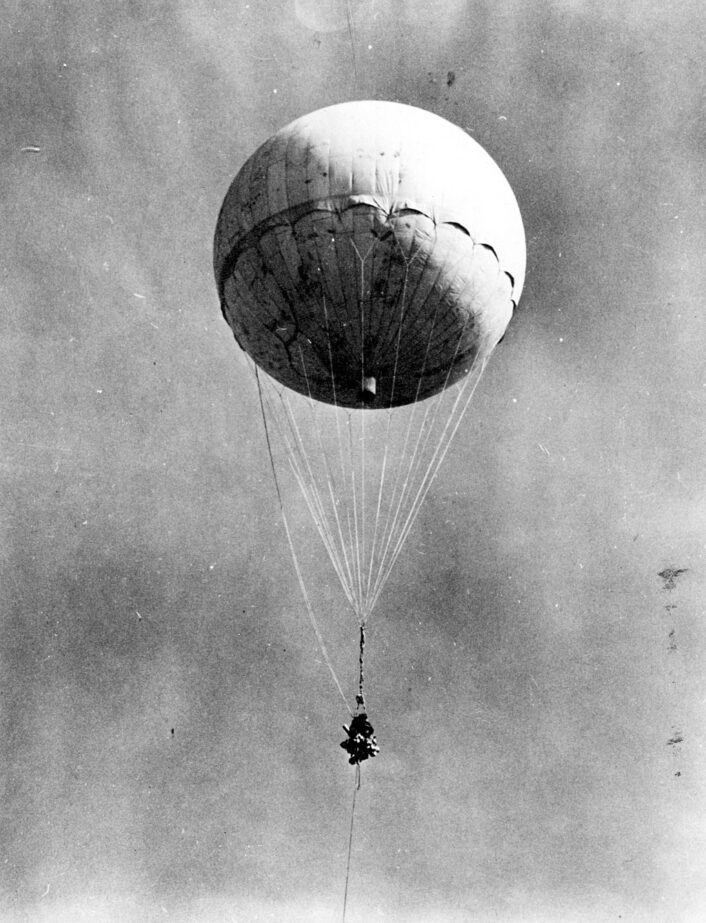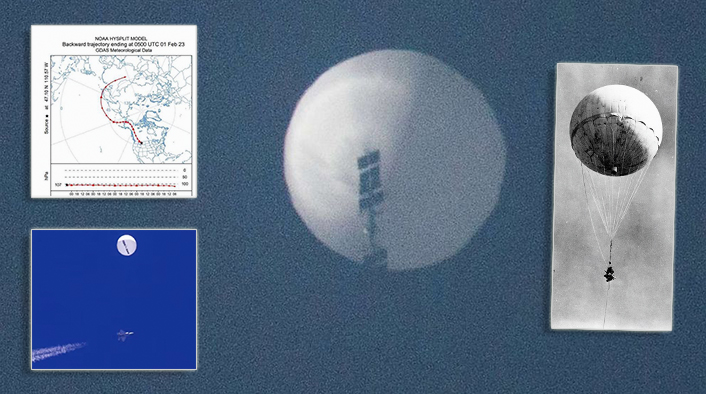Concerns About Surveillance Are Valid, But What About Weaponized Weather Modification?
The memes are funny. The headlines are fascinating. But the real concern about last week’s Chinese balloon incident is more than hot air. Chinese balloon operations over the U.S. may pose a genuine strategic risk. And this risk extends beyond the possibility of gathering intelligence about U.S. missile bases. What if the two Chinese balloons tracked across the western hemisphere last week could have been weaponized? History and literature suggest the concern over weaponized balloons has merit.
Historical precedents of weaponized balloons carrying everything from incendiary weapons to disease-infested fleas exist. And perhaps more ominously, recent activity in China suggests that significant advancements in weather modification – that could be delivered by balloons – have been recently deployed. While some of this analysis has the feel of crackpot conspiracy theory, the facts show that high altitude balloons pose a genuine strategic threat as a plausible weapons delivery system.
In December, 2020, Bloomberg.com reporter Adam Minter wrote, “China announced plans to expand its rainmaking capabilities to cover nearly 60% of the country by 2025. Details are sketchy, but fears are rising about the potential military uses of these capabilities, and their effects on an already changing climate.” Minter’s report was fascinating, even though he didn’t connect the dots to include mention of weather modification being delivered by long range, high altitude balloons.
Three years ago, when Minter reported on Chinese efforts to seed clouds to moderate a regional drought, concern over Chinese balloon overflights had not yet gone viral. But his report recognized the potential for weaponizing the ability to control weather, potentially creating floods and mudslides. This is a capability easily delivered by high altitude balloons. More than half a century before this, in a July 3, 1972 expose’, The New York Times special reporter Seymour M. Hersh wrote about the formerly top-secret U.S. weaponized rain making efforts in Laos, Cambodia, North and South Vietnam. Hersh reported that, “The United States has been secretly seeding clouds over North Vietnam, Laos and South Vietnam to increase and control the rainfall for military purposes. Government sources, both civilian and military, said during an extensive series of interviews that the Air Force cloud seeding program has been aimed most recently at hindering movement of North Vietnamese troops and equipment and suppressing enemy antiaircraft missile fire.”
While there is no empirical evidence of any sinister intent in the widely-hyped Chinese balloon incident, the potential for weaponized balloon overflight has historical precedent. Recall the WWII Japanese balloon bombing campaign on the mainland United States. In a dark corner of the National Museum of the United States Air Force at Wright-Patterson Air Force Base in Dayton, Ohio, a small exhibit tucked behind a P-39 Airacobra recalls the bizarre Fu-Go balloon bombing campaign waged against the United States by Japan. Artifacts include fragments from a Japanese balloon and one of the weapon delivery rings that was suspended below the balloon as it crossed the Pacific on its way to the Northwestern United States. The Japanese balloons dropped incendiary weapons in forests to start forest fires. And they killed people.
The Japanese Fu-Go balloon attacks on the U.S. mainland have remained largely obscure, a bizarre footnote to history. But the scope of the Japanese balloon campaign turned out to be more significant, and potentially deadly, than was reported during WWII. In fact, the actual threat of the Japanese Fu-Go balloons was heavily suppressed in an effort to avert mass panic.
Author and researcher Ross Coen wrote in his November 2014 book, “Fu-Go: The Curious History of Japan’s Balloon Bomb Attack on America”, that, “The Ninth Military Technical Institute, more commonly called the Noborito Institute, occupied an expansive compound on a bluff above the Tama River in southwest Tokyo. Founded in 1927 by Captain Ryo Shinoda as part of the Army Science Research Institute, Noborito began as a small research division dedicated to covert warfare. Shinoda, a chemist who had studied at the prestigious Tokyo Imperial University, at first mined spy novels and movies for ideas about intelligence and counterintelligence operations. Eventually the laboratory moved on to more lethal applications, including poisons and biological agents that could be used to destroy crops and livestock.” Coen also wrote about one of the few Japanese balloon attacks on the U.S. to achieve notoriety. On May 5, 1945, six people, mostly children, died in an explosion outside Lakeside, Oregon when they tried to examine a Japanese Fu-Go balloon-borne incendiary bomb that had drifted across the Pacific on the Jetstream winds and landed in a forest.

And what about the plausibility of using weather manipulation, potentially delivered by high altitude balloons, as a strategic weapon?
In 1972, Hersh wrote that, “The weather manipulation in Indochina, which was first tried in South Vietnam in 1963, is the first confirmed use of meteorological warfare.” But there is no record of it being the last. In fact, concern over weaponized weather manipulation was significant enough to warrant the United Nations drafting the October 5, 1978, “Prohibition of Military or Any Other Hostile Use of Environmental Modification Techniques (ENMOD)”. This prohibition effectively asserts that nations will not use weather modification as a weapon. But not every nation signed the prohibition, an even some of those that did remain active in weather modification research. Not unlike nuclear science, the ability to differentiate between benevolent scientific endeavor and weapons research in weather modification is almost impossible. One looks nearly identical to the other, and both have a history of employing high altitude balloons.
In Minter’s 2020 report for Bloomberg.com, he wrote that, “Although China ratified the (ENMOD) treaty in 2005, its interest in controlling the weather and the environment didn’t wane. Meteorological calamities such as hail and flooding account for more than 70% of the country’s annual disaster-related damage. Because of that ongoing toll, the government has staked its legitimacy in part on how well it responds to such incidents. In recent decades, as the country has grown wealthier, Earth-altering projects such as the Three Gorges Dam have become a favored solution.”
Of perhaps even greater relevance to concerns about high altitude balloons being used in weaponized weather modification, Minter writes, “Weather modification, by comparison, is relatively inexpensive. In the 1980s, the government began making substantial investments in cloud physics and related fields. Advances in everything from satellites to rocketry boosted the effort, even though definitive scientific proof for the effectiveness of cloud seeding emerged only in 2018 (and in Idaho, not China). Nonetheless, the government claimed a great success in 2008, when Beijing launched 1,110 allegedly rain-suppressing rockets to ensure that the Olympic opening ceremonies were dry (they were, although scientists have questioned whether the rockets had much to do with it). By 2015, there were rainmaking and hail-suppression programs in 30 Chinese provinces, employing some 35,000 people.”
In the way that fiction so frequently predates fact, popular author Brad Thor’s 2015 novel, “Act of War”, features a series of Chinese balloons released over the United States to execute an electromagnetic pulse syndrome (EMP) attack that disables communications and electronics on a national scale. Given last week’s headline, Thor’s plot seems prescient today. While we wait for the official report on findings from the Chinese balloon wreckage, this survey of history and literature about weaponized balloons, China’s weather control activities and other ominous possibilities paints a frightening picture. And whether these storylines come from the pages of well-written fictional thrillers, history books or university research findings, it’s worth understanding them as we navigate the increasingly turbulent interactions with Beijing.








